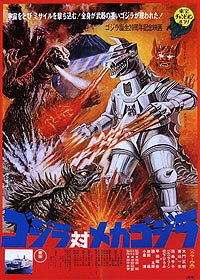Gojira tai Mekagojira |
      • Directed by: Jun Fukuda. • Starring: Masaaki Daimon, Kazuya Aoyama, Reiko Tajima, Akihiko Hirata, Hiromi Matsushita, Hiroshi Koizumi, Masao Imafuku, Bellbella Lin, Shin Kishida, Gorô Mutsumi, Daigo Kusano, Takayasu Torii, Kenji Sahara. • Music by: Masaru Satô. • Directed by: Jun Fukuda. • Starring: Masaaki Daimon, Kazuya Aoyama, Reiko Tajima, Akihiko Hirata, Hiromi Matsushita, Hiroshi Koizumi, Masao Imafuku, Bellbella Lin, Shin Kishida, Gorô Mutsumi, Daigo Kusano, Takayasu Torii, Kenji Sahara. • Music by: Masaru Satô.      This time, the overgrown-lizard hero is confronted by a mechanical doppelganger, courtesy of an army of extraterrestrial apes. Unable to best his metallic twin in combat, Godzilla seeks out the aid of Okinawan monster god King Seeser. The film is peppered with moments of humor, which sometimes aren't as funny as the more serious monster vs. monster battles. So much happens in the final reel that one is disappointed not to see the kitchen sink. After the TV popularity of The Six Million Dollar Man and The Bionic Woman, Godzilla vs. Mechagodzilla was rechristened Godzilla vs. the Bionic Monster. This time, the overgrown-lizard hero is confronted by a mechanical doppelganger, courtesy of an army of extraterrestrial apes. Unable to best his metallic twin in combat, Godzilla seeks out the aid of Okinawan monster god King Seeser. The film is peppered with moments of humor, which sometimes aren't as funny as the more serious monster vs. monster battles. So much happens in the final reel that one is disappointed not to see the kitchen sink. After the TV popularity of The Six Million Dollar Man and The Bionic Woman, Godzilla vs. Mechagodzilla was rechristened Godzilla vs. the Bionic Monster.
|
Trailers:
| Length: | Languages: | Subtitles: |
Review:












In this film, the Simians, ape-like aliens from a distant galaxy similar to ours, have their eyes set on Earth's destruction. To accomplish this task, they've built the cyborg monster Mechagodzilla. Of course, much like the Terminator cyborg, Mechagodzilla appears wearing a rubber disguise of the real Godzilla. Soon enough, the real Godzilla does appear and unmasks his robotic doppelganger, revealing the creature in all its shiny, space titanium glory.
Mechagodzilla is unique amongst Toho kaiju (monsters) because it is the only monster, in any incarnation of the character, to ever actually come close to actually killing the great King of the Monsters. Yes, that's right. Godzilla actually comes pretty close to biting the big one in no due part to his heavily armed, heavily armored mechanical twin nemesis; Lord knows, Godzilla does bleed enough during his final confrontation with Mechagodzilla to warrant a young one to cover their eyes in horror at Our Monster Hero bleeding profusely during battle with an enemy that may just send him to his maker. (I don't believe any other monster has ever come close to accomplishing this task, not even the monster Destoroyah from 1995's "Godzilla vs. Destoroyah.") But Godzilla does have some help here, mostly in the form of long-time ally Anguirus (who throws the humans onto the evil aliens' plot) and series newcomer King Caesar, a monster-god of Okinawan origin that is an awkward combination of a dog and a lion.
A lot of people will comment about the special effects here, which are flawed indeed due to Toho's well-documented financial troubles in the early 1970s. But that doesn't stop the fact that "Godzilla vs. Mechagodziila" does have some of the best pyrotechnic effects of any film from the Showa series. I'm talking about when Godzilla and Mechagodzilla first fight at the oil refinery, to Godzilla's "shocking" return to Monster Island where he recharges after said fight, and the final three-way showdown between Godzilla, Mechagodzilla, and King Caesar in Okinawa.
"Godzilla vs. Mechagodzilla" is still one of my favorites, though, despite its flaws. It features a key supporting role from the late, great, long-time "Godzilla" actor Akihiko Hirata as Professor Miyajimi (he first appeared as the tortured Dr. Serizawa in the original 1954 "Godzilla"), who is kidnapped and forced by the aliens to help repair Mechagodzilla after the monster's head controls are damaged during its initial confrontation with Godzilla. There's also a lot of James Bond-like intrigue thrown into the plot, amongst various other elements from American spy movies, which were incredibly popular at the time and allow the film to flow at an incredibly rapid pace. This movie also has one of the most beautiful and exotic scores (by Masaru Satoh) of any film from the Showa series, largely because it makes good use of the alternating mainland JapanOkinawan locations in the story.
"Godzilla vs. Mechagodzilla" was followed by a direct sequel titled "Terror of Mechagodzilla" one year later in 1975, which would mark the end of the first generation of "Godzilla" pictures before "Godzilla 1985" (1984) marked the rebirth of the King of the Monsters for the Heisei series of films, and he was once again returned to his roots as a fearsome, rampaging menace.
Review by dee.reid from the Internet Movie Database.
Movie Database